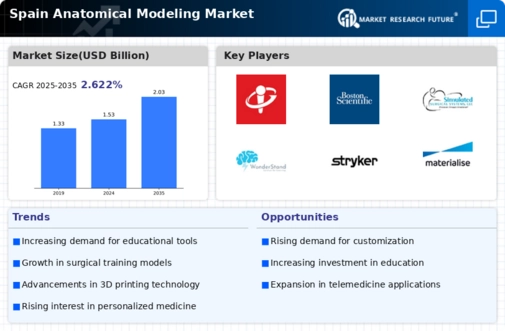Rising Healthcare Expenditure
The anatomical modelling market in Spain is experiencing growth due to the increasing healthcare expenditure. The Spanish government has been investing heavily in healthcare infrastructure, which has led to a rise in the adoption of advanced medical technologies. In 2025, healthcare spending in Spain is projected to reach approximately €200 billion, reflecting a growth rate of around 5% annually. This increase in funding allows for the procurement of sophisticated anatomical models, which are essential for medical training and surgical planning. As hospitals and educational institutions allocate more resources towards innovative solutions, the anatomical modelling market is likely to benefit significantly from this trend.
Surge in Medical Education Initiatives
The anatomical modelling market is being positively influenced by a surge in medical education initiatives across Spain. With the increasing number of medical schools and training programs, there is a heightened demand for realistic anatomical models that enhance learning experiences. In 2025, it is estimated that the number of medical students in Spain will exceed 50,000, creating a substantial market for educational tools. These models facilitate better understanding of human anatomy, thereby improving the quality of medical education. Consequently, the anatomical modelling market is expected to expand as educational institutions seek to invest in high-quality resources to train future healthcare professionals.
Increased Focus on Patient-Centric Care
The anatomical modelling market is benefiting from an increased focus on patient-centric care within the Spanish healthcare system. As healthcare providers strive to improve patient outcomes, there is a growing recognition of the importance of personalized treatment plans. Anatomical models play a crucial role in this approach, enabling healthcare professionals to visualize and understand individual patient anatomies. This trend is likely to drive demand for anatomical models that can be tailored to specific cases, thereby enhancing the quality of care. As patient-centric practices become more prevalent, the anatomical modelling market is expected to expand in response to these evolving healthcare priorities.
Growing Interest in 3D Printing Technology
The anatomical modelling market is witnessing a transformation due to the growing interest in 3D printing technology. This innovative approach allows for the creation of highly detailed and customized anatomical models, catering to specific patient needs. In Spain, the 3D printing market is projected to grow at a CAGR of 20% from 2025 onwards, indicating a robust demand for personalized medical solutions. As healthcare providers increasingly adopt 3D printing for surgical planning and patient education, the anatomical modelling market is likely to see a corresponding rise in demand for 3D-printed models, which offer enhanced accuracy and cost-effectiveness.
Expansion of Research and Development Activities
The anatomical modelling market is experiencing growth due to the expansion of research and development activities in Spain. With a strong emphasis on innovation, various research institutions and universities are investing in the development of advanced anatomical models for both educational and clinical applications. In 2025, R&D spending in the healthcare sector is anticipated to reach €10 billion, fostering advancements in anatomical modelling technologies. This investment not only enhances the quality of models but also encourages collaboration between academia and industry. As R&D activities continue to flourish, the anatomical modelling market is likely to benefit from the introduction of cutting-edge solutions that meet the needs of healthcare professionals.





















Leave a Comment